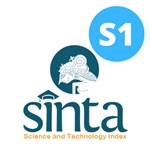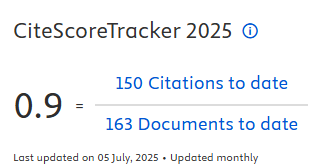The Correlation between Gender and Work Stress with the Fatigue of Lecturers
Downloads
Introduction: Lecturers are workers who are actively involved in educational, research and community service activities at a college. Many duties and responsibilities of lecturers in their work can cause fatigue which is the body's response as a defense mechanism when the work exceeds its capacity. Different capacities can be assessed based on gender which also allows differences in response to the problem. The inability to cope with a problem or job produces a feeling of depression which can also be called as stress. The purpose of this study was to analyze the correlation between gender and work stress with fatigue at a faculty lecturers at a university in Surabaya. Method: This research was an analytical descriptive study in a faculty lecturers at a university in Surabaya. The study design was cross-sectional. Data were obtained through the results of a questionnaire distributed to lecturers who have met the criteria, as many as 43 respondents. Results: The study showed that 16 female respondents (57.2%) experienced moderate fatigue. About 19 respondents (63.3%) had mild stress and experienced mild fatigue. The correlation value between gender and fatigue was 0.816 and the strong correlation between work stress and fatigue was 0.000. This value indicated that there was no correlation between gender and fatigue, but there was a strong and direct correlation between work stress and fatigue. Conclusion: The occurrence of fatigue is not influenced by gender and high fatigue can be influenced by the high work stress felt by them.
Keywords:fatigue, gender, lecturer, work stress
Akbar, D. A. (2017) ‘Konflik Peran Ganda Karyawan Wanita dan Stres Kerja', An Nisa'a: Jurnal Kajian Gender dan Anak, 12(1), pp. 33–48.
Arini, S. Y. and Dwiyanti, E. (2017) ‘Analisis Faktor yang Berhubungan dengan Terjadinya Kelelahan Kerja pada Pengumpul Tol di Perusahaan Pengembang Jalan Tol Surabaya', The Indonesian Journal of Occupational Safety and Health, 4(2), p. 113.
Darmawan, A. A. Y. P., Silviandari, I. A. and Susilawati, I. R. (2015) ‘Hubungan Burnout dengan Work-Life Balance pada Dosen Wanita', Jurnal Mediapsi, 1(1), pp. 28–39.
Dewi, I. R., Hartanti, R. I. and Sujoso, A. D. P. (2016) ‘Hubungan antara Beban Kerja Mental dengan Stres Kerja pada Dosen di Universitas Jember', Artikel Ilmiah Hasil Penelitian Mahasiswa. Jember: Public Health Faculty, Universitas Jember.
Fitri, A. M. (2013) ‘Analisis Faktor-faktor yang Berhubungan dengan Kejadian Stres Kerja pada Karyawan Bank (Studi pada Karyawan Bank BMT)', Jurnal Kesehatan Masyarakat Universitas Diponegoro, 2(1).
Habibi, J. and Jefri (2018) ‘Analisis Faktor Risiko Stres Kerja Pada Pekerja Di Unit Produksi Pt. Borneo Melintang Buana Export', Jurnal Kesehatan Masyarakat, 6(2), pp. 50–59.
Ibrahim, H., Amansyah, M. and Yahya, G. N. (2016) ‘Faktor - Faktor yang Berhubungan Dengan Stres Kerja pada Pekerja Factory 2 PT. Maruki Internasional Indonesia Makassar', Al-Sihah : Public Health Science Journal, 8(1), pp. 60–68.
Jauhari, M. A. (2019) ‘Analysis on Factors Causing Fatigue among Steel Casting Workers at PT X Sidoarjo', The Indonesian Journal of Occupational Safety and Health, 8(2), pp. 224–232.
Kurniasari, I. and Hidayat, S. (2017) ‘the Influence of Work Stress on Improving Blood Pressure on Workers', The Indonesian Journal of Occupational Safety and Health, 6(3), pp. 385–393.
Maurits (2010) Selintas Tentang Kelelahan Kerja'. Yogyakarta: Amara Books.
Mutia, A. (2018) Analisis Kelelahan Kerja pada Dosen-Dosen Fakultas Ekonomi dan Bisnis Universitas Muhammadiyah Sumatera Utara. Undergraduate Thesis. Medan: Universitas Muhammadiyah Sumatera Utara.
Pertiwi, E. M., Denny, H. M. and Widjasena, B. (2017) ‘Hubungan Antara Beban Kerja Mental Dengan Stres Kerja Dosen Di Suatu Fakultas', Jurnal Kesehatan Masyarakat (e-Journal), 5(3), pp. 260–268.
President of Republic Indonesia (2005) ‘Undang - Undang Republik Indonesia Nomor 14 Tahun 2005', File Negara Republik Indonesia. Indonesia.
President of Republic Indonesia (2012) ‘Undang-undang Republik Indonesia Nomor 12 Tahun 2012', File Negara Republik Indonesia. Indonesia.
Ramayanti, R. (2015) ‘Analisis Hubungan Status Gizi dan Iklim Kerja dengan Kelelahan Kerja di Catering Hikmah Food', The Indonesian Journal of Occupational Safety and Health, 4(2), pp. 177–186.
Sukadiyanto (2013) ‘Perbedaan Reaksi Emosional Antara Olahragawan Body Contact dan Non Body Contact', Jurnal Psikologi, 33(1), pp. 50–62.
Suma'mur (2013) Hygiene Perusahaan dan Kesehatan Kerja (Hiperkes'. Edisi 2. Jakarta: Sagung Seto.
Syamsuri, M. (2018) Faktor yang Berhubungan dengan Kelelahan Kerja pada Pekerja Pengumpul Tol PT Margautama Nusantara Kota Makassar Tahun 2018. Undergraduate Thesis. Makassar: Faculty Public Health, Universitas Hasanuddin.
Tamaela, E. Y. (2011) ‘Konsekuensi Konflik Peran , Kelebihan Beban Kerja dan Motivasi Intrinsik terhadap Burnout pada Dosen yang', Aset, 13(2), pp. 111–122.
Tarwaka (2013) Ergonomi Industri Dasar – dasar Pengetahuan Ergonomi dan Aplikasi di Tempat Kerja. Surakarta: Harapan Press.
Wayanti, S., Suryaningsih and Esyuananik (2016) ‘Kelelahan Kerja (Burnout Syndrom) pada Dosen Berdasarkan Karakteristik Demografi, Harapan, Penghargaan dan Kontrol', Jurnal Penelitian Kesehatan ‘Suara Forikes' (Journal of Health Research ‘Forikes Voice'), 7(1), pp. 39–45.
Widyastuti, A. D. (2018) ‘Hubungan Stres Kerja Dengan Kelelahan Kerja Pada Pekerja Area Workshop Konstruksi Box Truck', The Indonesian Journal of Occupational Safety and Health, 6(2), p. 216.
Yani, M. D. and Dwiyanti, E. (2017) ‘Hubungan Kompensasi Finansial Dan Stres Kerja Dengan Kinerja Karyawan PT. Dok Dan Perkapalan Surabaya (Persero)', The Indonesian Journal of Occupational Safety and Health, 5(2), p. 163.
Yogisutanti, G. (2016) ‘Lama Tidur dan Akumulasi Kelelahan Kerja Pada Dosen', Jurnal Kesehatan Masyarakat, 11(1), p. 17.

In order to be accepted and published by The Indonesian Journal of Occupational Safety and Health, Author(s) who submit an article should complete all the review process. The copyright of received articles assigned to the The Indonesian Journal of Occupational Safety and Health and Department of Safety and Health, Universitas Airlangga as publishers of the journal. The intended copyright includes the rights to publish articles in various forms (including reprints).
The Editorial Team of The Indonesian Journal Of Occupational Safety and Health and Department of Safety and Health strive to ensure that no errors occur in the articles that have been published, both data errors and statements in the article.
Users of this website will be licensed to use materials from this website following the Creative Commons Attribution-NonCommercial-ShareAlike 4.0 International License. No fees charged. Please use the materials accordingly.
------------------------------------------------------------------------------------------------------------------------------------------------------------------------------------------
Attribution ” You must give appropriate credit, provide a link to the license, and indicate if changes were made. You may do so in any reasonable manner, but not in any way that suggests the licensor endorses you or your use.
NonCommercial ” You may not use the material for commercial purposes.
ShareAlike ” If you remix, transform, or build upon the material, you must distribute your contributions under the same license as the original.







 How to Submit Articles in OJS
How to Submit Articles in OJS

























